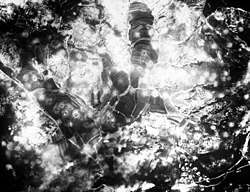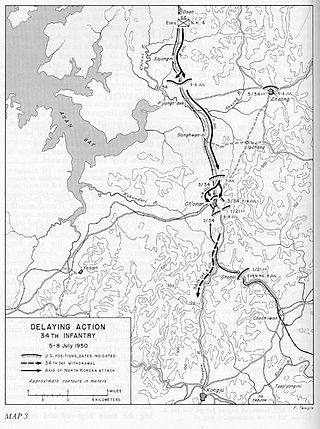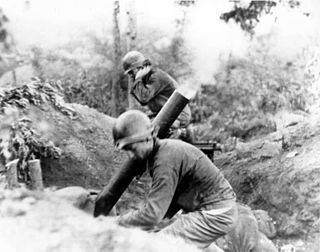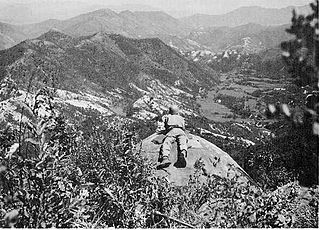UN Forces
Ground

The United Nations forces were organized under the command of the United States Army. The Eighth United States Army served as the headquarters component for the UN forces, and was headquartered at Taegu. [1] [2] Under it were three weak US Divisions; the 24th Infantry Division was brought to the country early in July, while the 1st Cavalry Division and 25th Infantry Division arrived between July 14 and July 18. [3] These forces occupied the western segment of the perimeter, along the Naktong river. [4]
The Republic of Korea Army, a force of 58,000, [5] was organized into two corps and five divisions; from east to west, ROK I Corps controlled the 8th Infantry Division and Capital Divisions, while the ROK II Corps controlled the 1st Division and 6th Infantry Division. A reconstituted ROK 3rd Division was placed under direct ROK Army control. [6] [7] Morale among the UN units was low due to the large number of defeats at that point in the war. [1] [8] US Forces had suffered over 6,000 casualties over the past month while the South Korean Army had lost an estimated 70,000. [9] [10]

Troop numbers at the beginning of the battle were initially difficult to estimate for US and North Korean forces. Subsequent research indicates that the North Korean army had around 70,000 combat troops committed to the Pusan Perimeter on August 5, with most of its divisions far understrength. [9] [11] It likely had less than 3,000 personnel in mechanized units, and around 40 T-34 tanks at the front due to extensive losses so far in the war. [9] [12] MacArthur reported 141,808 UN troops in Korea on August 4, of which 47,000 were in US ground combat units and 45,000 were in South Korean combat units. Thus the UN ground force outnumbered the North Koreans 92,000 to 70,000. [9] [12]
Throughout September 1950 as the battle raged, more UN forces arrived from the US and other locations. [13] The 2nd Infantry Division, 5th Regimental Combat Team, [14] and 1st Provisional Marine Brigade and a British Army brigade arrived in Pusan later in the fighting, along with large numbers of fresh troops and equipment, including over 500 tanks. [4] [15] By the end of the battle, Eighth Army's force had gone from three under-strength divisions to four fully manned formations which were well equipped and well prepared for war. By the end of the battle, the 27th British Commonwealth Brigade had arrived to assist the American and South Korean units. [16]
US 8th Army
![]() Eighth United States Army
Eighth United States Army
Commander: Lieutenant General Walton H. Walker [3]
| Unit | Sub-units | Notes |
|---|---|---|
| Major General Hobart R. Gay |
| Reported a strength of 10,276 on August 4 [12] [18] Stood at 14,703 by September 1. [19] |
| Major General Laurence B. Keiser |
| Reported a strength of 4,922 in Korea on August 4 [12] [21] Stood at 17,498 by September 1. [19] |
| Major General John H. Church |
| Reported a strength of 14,540 on August 4 [25] Stood at 14,739 by September 1. [19] |
| Major General William B. Kean |
| Reported a strength of 12,073 on August 4 [12] [28] Stood at 15,007 by September 1. [19] |
| Brigadier General Edward A. Craig |
| Reported a strength of 4,725 on August 5. [30] Stood at 4,290 by September 1. [19] |
| Brigadier Basil Coad |
| Arrived 26 August, having left one battalion in Hong Kong. Stood at 1,578 by September 1. [19] |

ROK Army
| Minister of Defense: Shin Sung-mo | ||||||||||
|---|---|---|---|---|---|---|---|---|---|---|
| Unit | Commander | Sub-units | Notes | |||||||
| | Brigadier General Lee Jun Shik [34] |
| Reported directly to ROK Army command. Reported a strength of 8,829 on July 26. [6] [35] Stood at 7,154 by September 1. [36] | |||||||
| | Brigadier General Kim Hong-il | Headquarters reported a strength of 3,014 on July 26. [6] [35] Stood at 1,275 by September 1. [36] | ||||||||
| | Brigadier General Kim Suk-won [37] |
| Reported strength of 6,644 July 26. [6] [35] Stood at 16,376 by September 1 [36] | |||||||
| | Colonel Lee Song Ga [37] |
| Reported strength of 8,864 July 26. [6] [35] Stood at 9,106 by September 1. [36] | |||||||
| | Brigadier General Yu Jae Hung | Headquarters reported a strength of 976 on July 26. [6] [35] Stood at 499 by September 1. [36] | ||||||||
| | Brigadier General Paik Sun-yup |
| Reported a strength of 7,601 on July 26. [6] [35] Stood at 10,482 by September 1. [36] | |||||||
| | Colonel Kim Chong O [37] |
| Reported a strength of 5,727 on July 26. [6] [35] Stood at 9,300 by September 1. [36] | |||||||
Air

UN forces had a massive arsenal of air support at their disposal, provided by the US Air Force. This support was provided primarily by the Far East Air Forces (FEAF) and the Fifth Air Force, but US Navy and US Marine Corps aviation played a substantial role in supporting operations from the sea. UN Forces had complete control of the air and sea throughout the fight. and US Air Force and US Navy elements provided support for the ground units throughout the battle virtually unopposed. [38] By the end of the battle the Eighth Army had more air support than General Omar Bradley's Twelfth United States Army Group in Europe during World War II. [39] [40]
By the end of July, the US had shipped a large number of aircraft of all types to Korea. On 30 July, the Far East Air Forces had 890 planes-626 F-80's and 264 F-51's-but only 525 of them were in units and available and ready for combat. [14]

The Far East Air Force commanded a large contingent of long-range heavy bomber aircraft, and these assets were based in Japan, far from the North Koreans' striking range. Generally, the massive striking power was too unwieldy for the UN to use against the dispersed North Korean units, and the airpower of FEAF's B-29 Superfortresses was passed over in favor of smaller and more versatile fighter bombers of the Fifth Air Force. Under orders from MacArthur, however, the FEAF bomber command conducted one mission during the Pusan Perimeter fights. [41] [42]
On August 16, in the midst of the fight around Taegu, conducted one large carpet bombing operation northwest of Waegwan, where up to 40,000 North Korean troops were believed to be massing. The bombers from 10,000 feet dropped approximately 960 tons of 500- and 1,000-pound bombs. [41] [42] The attack had required the entirety of the FEAF bombing component, and they had dropped 3,084 500 pounds (230 kg) bombs and 150 1,000 pounds (450 kg) bombs. This comprised the largest Air Force operation since the Battle of Normandy in World War II. [43]
General Walker reported to General MacArthur the next day that the damage done to the North Koreans by the bombing couldn't be evaluated because of smoke and dust, and ground forces couldn't reach it because of North Korean fire. [42] Information obtained later from North Korean prisoners revealed the enemy divisions the Far East Command thought to be still west of the Naktong had already crossed to the east side and were not in the bombed area. [44] No evidence was found that the bombing killed a single North Korean soldier. [43]
However, the bombing seems to have destroyed a significant number of North Korean artillery batteries. The UN ground and air commanders opposed future massive carpet bombing attacks against enemy tactical troops unless there was precise information on an enemy concentration and the situation was critical. [44] Instead, they recommended fighter-bombers and dive bombers would better support ground forces. [43] They subsequently canceled a second bombing of an area east of the Naktong scheduled for August 19. [41] [44]
Far East Air Force and 5th Air Force

| Commander: Lieutenant General George E. Stratemeyer | ||||||||||
|---|---|---|---|---|---|---|---|---|---|---|
| Unit | Sub-units | Aircraft | Notes | |||||||
| | B-29 Superfortress | [41] | ||||||||
| | B-29 Superfortress | [41] | ||||||||
| | B-29 Superfortress | [41] | ||||||||
| | B-29 Superfortress | [41] | ||||||||
| | B-29 Superfortress | [41] | ||||||||
| | F-80 Shooting Star, F-82 Twin Mustang | [45] [46] [47] | ||||||||
| | F-82 Twin Mustang, F-94 Starfire, F-86 Sabre | [45] | ||||||||
| | F-80 Shooting Star, F-86 Sabre | [45] | ||||||||
| | RB-26 Invader, RF-80A Shooting Star, RF-51D Mustang | [45] | ||||||||
| | RB-29 Superfortress | [45] | ||||||||
| | RB-17G Flying Fortress | [45] | ||||||||
Naval aircraft
The US Navy and Marine Corps aviation elements came to bear against the North Korean forces from five carriers during the battle: USS Valley Forge with Carrier Air Group 5, USS Philippine Sea with Carrier Air Group 11, HMS Triumph with two squadrons of the Fleet Air Arm, and two smaller carriers that supported Marine aircraft of the 1st Marine Aircraft Wing. Carrier Air Group 5 was the only Carrier-based air wing in the Far East at the time of the outbreak of war. [48] Many of the pilots operating these aircraft were World War II veterans, however budget cuts following the end of the war had greatly reduced their training and readiness in the months before the war. [49]
Early in the war, these aircraft were used primarily to conduct raids and gather intelligence on North Korean ground targets, focused on disrupting North Korean supply to the front lines. [50] However, as soon as UN forces retreated to Pusan Perimeter following the Battle of Taejon, the Naval aircraft were immediately re purposed for close-air support and airstrikes against North Korean ground troops on the front. [51] These missions were significantly more risky and the aircraft suffered much higher losses due to North Korean ground fire. [52]
Sea

The UN forces also had at their disposal a massive naval force of multi-national composition, which assisted in the defense of Pusan Perimeter at several crucial junctures. Ships of the fleet provided supporting artillery fire during pitched ground battles [55] and provided a route of resupply and evacuation during other junctures. [56] [57] Multiple aircraft carriers provided bases for large contingents of aircraft that flew sorties and air strikes over North Korean ground forces. [58] [59]
UN ships continued to stream into the theater during and after the Pusan Perimeter engagement, and they played varying roles in support of the battle. [54] The fleet was split into three primary groups; Task Force 77 formed the primary Aircraft carrier and striking component of the fleet, Task Force 96 consisted of a variety of smaller ships concerned with coastal bombardment, and Task Force 90 formed an attack transport squadron to assist in the evacuation and movement of ground troops. [60]
Overall command of the naval force was taken by the US Seventh Fleet, and the bulk of the naval power provided was also from the US. [60] The United Kingdom also provided a small naval task force including an aircraft carrier and several cruisers. Eventually, Australia, Canada and New Zealand provided ships as well. [61] The Republic of Korea Navy itself was almost negligible during the battle. The South Koreans had a very small navy consisting of a few dozen minesweepers, LSTs, PT boats and other small craft donated to them by other UN member states. Compared to the larger UN fleet these craft played a very small role in the engagement, but North Korean naval ships, which were also very small, tended to target the ROK fleet more often. [62]
US 7th Fleet
Under Vice Admiral Arthur D. Struble, Task Force 77 formed the core Carrier striking force of the UN forces. The force contained the UN aircraft carriers as well as a number of attendant escorts. [60] The lineup of the escorts differed as ships were assigned roles in Task Force 96 during the course of the battle. [61]
| Ship name | Class | Notes |
|---|---|---|
| | Essex-class aircraft carrier | Arrived in theater in early July with Carrier Air Group 5. [54] [63] |
| | Essex-class aircraft carrier | Arrived in theater August 5 with Carrier Air Group 11. Served as Task Force 77 flagship. [54] |
| | Colossus-class aircraft carrier | 1st Aircraft Carrier Squadron, Far East Fleet. Arrived in theater July 1 with two squadrons of UK Fleet Air Arm. [61] |
| | Commencement Bay-class escort carrier | [54] [63] |
| | Commencement Bay-class escort carrier | [54] [64] |
| | Oregon City-class heavy cruiser | [64] |
| | Baltimore-class heavy cruiser | [64] |
| | Cleveland-class light cruiser | [64] |
| | Worcester-class light cruiser | [64] |
| | Crown Colony-class light cruiser | Arrived in theater August 29. [65] |
| | Town-class light cruiser | Arrived in theater July 1. [61] |
| | Gearing-class destroyer | [66] |
| | Allen M. Sumner-class destroyer | [64] |
| | Allen M. Sumner-class destroyer | [64] |
| | Allen M. Sumner-class destroyer | Arrived in theater July 2010 [67] |
| | Gleaves-class destroyer | [64] |
| | Gleaves-class destroyer | [67] |
| | Gearing-class destroyer | [67] |
| | Gearing-class destroyer | [67] |
| | Gearing-class destroyer | [67] |
| | Gearing-class destroyer | [67] |
| | Gearing-class destroyer | Arrived in theater August 19 [67] |
| | Gearing-class destroyer | Arrived in theater July 1950 [67] |
| | Gearing-class destroyer | Arrived in theater June 1950 [67] |
| | Gearing-class destroyer | Arrived in theater August 1950 [67] |
| | Gearing-class destroyer | Arrived in theater August 1950 [67] |
| | Fletcher-class destroyer | Arrived in theater July 3. [67] |
| | C-class destroyer | Arrived in theater June 29. [61] |
| | C-class destroyer | Arrived in theater June 29. [61] |
| | Unicorn class | 1st Aircraft Carrier Squadron, Far East Fleet. Arrived in theater August 29. Although able to operate as an aircraft carrier, she served in her usual role as an aircraft repair and maintenance carrier and was not actively engaged in combat. [68] |
Task Force 96 , under Vice Admiral C. Turner Joy, was the largest organization of UN forces by number of ships. The force consisted primarily of cruisers, destroyers, and other smaller ships, which were used to blockade North Korean waterways and conduct coastal bombardments. Ships in this role would also periodically switch to Task Force 77, acting as a screen and escort for the UN aircraft carriers. This force was also the most diverse of the forces, as ships from five nations would eventually be assigned to it. [61]
| Ship name | Class | Notes |
|---|---|---|
| | Baltimore-class heavy cruiser | [69] |
| | Atlanta-class light cruiser | [54] |
| | Crown Colony-class light cruiser | [70] |
| | Crown Colony-class light cruiser | Arrived in theater June 30. [70] |
| | Town-class light cruiser | Flagship of 1st Aircraft Carrier Squadron, Far East Fleet. [71] Arrived in theater June 31. [70] |
| | Allen M. Sumner-class destroyer | [72] |
| | Allen M. Sumner-class destroyer | [72] |
| | Allen M. Sumner-class destroyer | [72] |
| | Allen M. Sumner-class destroyer | [67] |
| | Allen M. Sumner-class destroyer | [72] |
| | Allen M. Sumner-class destroyer | Arrived July 1950 [67] |
| | Allen M. Sumner-class destroyer | Arrived in theater July 1 [67] |
| | Gearing-class destroyer | [67] |
| | Gearing-class destroyer | [48] |
| | Gearing-class destroyer | [48] |
| | Gearing-class destroyer | Arrived in theater July 1950. [67] |
| | Gearing-class destroyer | [67] |
| | Gearing-class destroyer | [67] |
| | Gearing-class destroyer | [67] |
| | Gearing-class destroyer | Arrived in theater August 1950 [67] |
| | Gearing-class destroyer | Arrived in theater July 19. [67] |
| | Fletcher-class destroyer | [64] |
| | C-class destroyer | Arrived in theater July 1950. [73] |
| | C-class destroyer | Arrived in theater July 1950. [73] |
| | C-class destroyer | Arrived in theater July 1950. [74] |
| | Tribal-class destroyer | [73] |
| | V-class destroyer | [73] |
| | Tribal-class destroyer | [73] |
| | Tribal-class destroyer | [73] |
| | S-class destroyer | [73] |
| | River-class frigate | [75] |
| | Loch-class frigate | [76] |
| | Loch-class frigate | [77] |
| | Bay-class anti-aircraft frigate | Arrived in theater September 1950. Served primarily as an escort during the Battle of Inchon. [78] |
| | Bay-class anti-aircraft frigate | Arrived in theater September 11. Served primarily as a troop transport during the Battle of Inchon. [78] |
| | Black Swan-class sloop (convoy escort) | Arrived in theater June 30. [73] |
| | Black Swan-class sloop | Arrived in theater June 30. [73] |
| | Black Swan-class sloop | Arrived in theater June 30. [73] |
| | modified Bay-class frigate | An "Admiralty Yacht" or despatch vessel. Served as a headquarters ship. [79] |
| | Hospital ship | Served as the UN fleet's primary hospital ship [80] |
| | Tench-class submarine | Patrolled extreme north of Korean theater in the Soya Strait |
| | Tench-class submarine | [81] |
| | YMS-1-class minesweeper | [81] |
| | YMS-1-class minesweeper | [82] |
| | YMS-1-class minesweeper | [82] |
| | YMS-1-class minesweeper | [82] |
Task Force 90 , under Rear Admiral James H. Doyle, was primarily concerned with amphibious operations in the theater. As such, it contained no combat ships, only attack transports and a large number of LSTs. The force consisted entirely of US ships. [61] At least 15 LSTs were assigned to the force during the battle to support the attack transports. [83]
| Ship name | Class | Notes |
|---|---|---|
| | Mount McKinley-class command ship | [61] |
| | Bayfield-class attack transport | [61] |
| | Arcturus-class attack cargo ship | [83] |
| | Andromeda-class attack cargo ship | [83] |
| | Andromeda-class attack cargo ship | [84] |
| | Andromeda-class attack cargo ship | [84] |
| | Tolland-class attack cargo ship | [61] |
| | Abnaki-class tug | [61] |
| | Crosley-class high speed transport | [85] |
| | Crosley-class high speed transport | [85] |
| | YMS-1-class minesweeper | Arrived in theater July 1950. [67] |
Additionally, a number of other combat ships were used to ferry weapons and supplies to the growing UN force during the battle. These ships were not deployed in a combat role in this battle, though some would later be moved to combat service later on in the war. [61]
| Ship name | Class | Notes |
|---|---|---|
| | Colossus-class aircraft carrier | Carried additional aircraft for other carriers. [86] |
| | Essex-class aircraft carrier | Carried aircraft for US Air Force units. [14] |
| | Balao-class submarine | Ferried torpedoes and other weapons [61] |
| | Balao-class submarine | Ferried torpedoes and other weapons [61] |
| | Liberty ship | Carried tanks for UN ground forces. [87] |
| | Cargo ship | [72] |
















